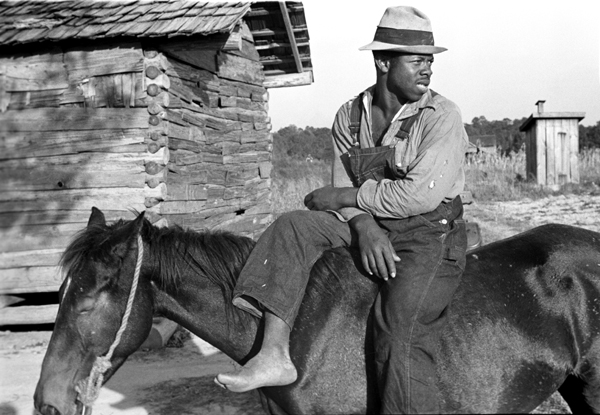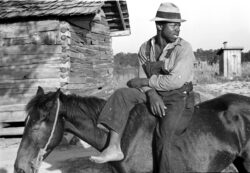Great Depression in Louisiana
During the Great Depression farm prices in Louisiana reached unheard-of lows and deepened rural poverty.
This entry is 8th Grade level View Full Entry

Library of Congress Prints and Photographs Division
"Strawberry Picker, Hammond, Louisiana," photographed by Ben Shahn, 1935.
What were the causes and events that led to the Great Depression?
During the 1920s Europe and much of the rest of the world suffered economic troubles following World War I. Yet during this time the United States seemed immune to the chaos of the outside world thanks to the growth of new technologies and the rapid rise of consumerism. By the end of the decade, though, the American economy was in deep trouble. Protectionist trade policies and unchecked speculation (high-risk, high-reward investment), the declining value of wages, and overproduction in agriculture and industry combined to bring the Great Depression to the United States.
These structural problems surfaced throughout the 1920s. Most notably, real estate busts in California and Florida during the mid-1920s were devastating. For most people, though, these problems hit all at once with the stock market crash in October 1929. By the end of the month, the stock market had lost an estimated 40 percent of its total value. The economy started to pick up in early 1930, giving President Herbert Hoover and the investing class a brief sense of hope before the market quickly resumed its disastrous slide, reaching a low in the summer of 1932, just before the presidential election that fall.
The stock market collapse on Wall Street highlighted the country’s slow economic breakdown, and the effects of the depression soon became visible in the wider economy. More than thirteen hundred banks failed in 1930 alone. More than twenty-six thousand businesses failed in 1930, followed by even more in 1931 and 1932. Foreign trade fell by 70 percent, while private investment in manufacturing dropped by 80 percent. In 1933 the US gross national product—the total value of goods and services produced at the time—was down more than half from its 1929 peak, and industrial output had fallen to 1913 levels. In short, within three years, all the gains of the World War I years and the 1920s were completely erased.
How did Louisiana experience the Great Depression?
Louisiana was greatly affected by the struggling economy, especially as farm prices declined to unheard-of lows. Louisiana was a mostly agricultural state. Cotton, for example, dropped to less than five cents a pound, sugar to less than four. The value of the state’s other leading products—timber, oil, and rice—experienced a similar decline. Many rural people already lived in deep poverty. The devastating 1927 Mississippi River flood and the drought of 1930–31 had displaced thousands of farm laborers and their families across the state. The sinking price for farm products put them in an even more unstable place where even basic subsistence—like the ability to feed and shelter themselves—was in doubt.
Lucille Watson, a relief fieldworker in Tensas Parish, described a situation typical in 1933. One sharecropper family she interviewed lived in a cabin where the walls were “one big crack” that had been pasted over with old catalogue pages and newspaper to keep the “wind and the rain from blowing into the house as much.” She also found another migrant family with a mother who was “depressed and miserable over their present condition” and children who “looked more or less sick and puny.” Watson also came across families with only a few bushels of sweet potatoes to last the winter season. Hard times were common in the state’s rural areas. Even wealthier planters and large landowners faced difficult times as farm income declined by two-thirds between 1929 and 1932. Many couldn’t pay their taxes or keep up with their mortgages, and eventually lost everything to a sheriff’s sale or to foreclosure.
Yet agricultural problems weren’t the only cause of suffering in Louisiana during the depression. The oil and gas industry experienced a slowdown in production that led to cutbacks and layoffs. Still, the oil business acted as a stabilizing force for the state’s economy throughout the 1930s, especially after a true recovery had begun by 1934–35. Baton Rouge, home of the Standard Oil refinery and associated plants, continued to expand during the decade. Shreveport and Monroe grew as well, as both were located amid vast oil and gas fields.
New Orleans, however, experienced some of the most severe effects of the depression in the state, similar to other large cities in the country. As the largest city in the South in 1930, and one of the country’s biggest ports, New Orleans faced the depression almost immediately. The decline in foreign trade emptied New Orleans’s warehouses and docks, leaving dockworkers jobless. By early 1930 one census counted at least ten thousand unemployed workers in the city. To meet the need for public relief, the city formed a welfare committee in early 1931 and raised more than half a million dollars from private donations. This money ran out in 1932, and city leaders proposed a $750,000 loan. However this wasn’t enough money to deal with the number of unemployed workers and their families.
Louisiana appears to have suffered less than other parts of the country. Governor (and later US Senator) Huey Long had made a commitment to infrastructure development when he took office in 1928. His willingness to spend millions of dollars on massive construction projects lessened the impact of the national economic crisis. These projects were similar to the objectives of the federal New Deal programs developed a few years later. Without the help of economic advisors or political scientists, Long instinctively pressed for increased spending in all areas of state government to promote economic growth. He built roads, bridges, and public facilities quickly and improved public education through the distribution of free textbooks, teacher pay raises, and adult literacy programs. Long spent more between 1928 and 1932 than the previous three state administrations combined.
Strangely Huey Long never endorsed direct government aid to unemployed workers or their families, such as small cash payments or even distribution of surplus food and clothes. His early construction program poured money into public works projects that provided employment opportunities for many laborers around the state. However, after about 1931, when he started getting into the national political picture, Long was more concerned with keeping his power in Louisiana than serving his constituents. Local sources of public charity provided much of the support for people facing hardship. In fact, churches, social clubs, benevolent societies, and other private sources funded 98 percent of all welfare expenditures in the state that year. And by the time these sources began to run out, even Herbert Hoover’s Republican administration had seen the need for a national relief program.
How did state and federal programs provide relief during the Great Depression?
Beginning with Hoover’s federal loans to states in the summer of 1932, relief became more regular. As a result of these funds, Governor O. K. Allen’s administration paid out $6.5 million between October 1932 and May 1933. Once Franklin D. Roosevelt took office as president in March 1933, this system was reorganized under the control of the Federal Emergency Relief Agency. Although federal dollars were often mishandled at the local level, they still had a big impact on relief. Later, after Long’s death in 1935, an even greater amount of money poured into Louisiana for projects that eventually employed thousands of blue- and white-collar workers.
As a result of the federal relief and recovery programs known as the New Deal, the desperation of the early years of the depression eased slightly. Although poverty and underemployment continued to affect many of the state’s working-class families until World War II, the problems of the early 1930s had improved. In fact, many Louisianans remember the second half of the decade as a golden era, a time of common purpose and feverish activity that saw major architectural projects undertaken and an explosion of artistic activity. The restoration of the French Market in New Orleans and the building of the Louisiana State Exhibit Museum in Shreveport occurred during this time. State colleges especially enjoyed well-funded building programs: Louisiana State University’s Tiger Stadium is only the most well known of the many New Deal buildings constructed on campuses around Louisiana in the 1930s. New parish courthouses, hospitals, and even airports were all built in this era. A Louisiana and New Orleans guidebook was also produced under Lyle Saxon’s direction, and murals celebrating Louisiana life and history were created. However, the deep anxiety and fear that filled Louisiana newspapers and personal letters during the depression remind us that this was indeed one of America’s most difficult times.
